#they can also be referred to as[vampire] btw- rather than [zombie]
Explore tagged Tumblr posts
Text
From yesterday but Qiqi/Nana-chan found! Tamura Yukari VA ☺️💕 aaa she’s so cute TT










Btw- Rather than zombie(ゾンビ, based off English word) Qiqi is actually a Kyonshi (キョンシー, aka translation of Jiangshi)... They’re slightly different :> Both dead ppl who were revived~
Cocogoat... -u-
#Genshin Impact#Genshin Impact Qiqi#Jiangshi#pls let them be more known#they can also be referred to as[vampire] btw- rather than [zombie]#Kanna plays Genshin Impact#and translates it or picks up stuff English tl missed at least..#I like zombies.. ofc ik theres types and slightly.. hmm.. that they’re lumped together.. ig most ppl don’t know so safest best :o#I’m so happy to meet Qiqi tho TT aaa~#btw.. there’s actually a lot of stuff like this in the tl 😂probs even more with CN ver but sadly my CN isn’t good enough compared to JP💦#they Anglicise or even just simplify a lot😂by this point I 1- wanna play with Jp text. 2-Kinda gave up tling#I’m tired and I probs miss stuff with JUST sound...#tho I’m too lazy to rewrite ALL the text hence.. eng text 😂 offical tl- I get ya -u- simplicity good👍
23 notes
·
View notes
Note
Anymore Touhou A Live fun facts?
Besides the fact that there are cute little references to other games scattered around? Hmmm-
I haven't talked much about the incarnates of Rage (the new Lord of Dark) for this game yet! They all have really good backstories, well except for one of them.
Draygion, a red dragon from the Wild chapter.

… There's nothing to note here. It's just a flying Odo that breathes fire. Virtually no differences. Cool design I guess, but otherwise a lackluster boss for the most lackluster chapter in the fan game.
He turns birds into yakitori I guess.
Ray Jihad, the vampire butler from the Gatekeeper chapter.

A commoner once hired by Remilia Scarlet but eventually fired due to pressure from her noble peers, who think strength only comes from blood rather than hard work. Rather than understanding since Remilia has the mind of a child, Jihad goes out to terrorize humanity and form his own army of commoners.
He ends up hiring Qiu Jin Lee (a gunslinger), who decides to blackmail criminal tengu via kidnapping and endangers children in order to lure out Reimu so she can't save Remilia.
Meiling ends up defeating him and Jihad is hoisted by his own petard, the Solar Arrow. The dude spent too much time monologuing in front of Remilia rather than actually getting the job done.
He kills Yun Jou, which honestly makes his spiel about the strength of hard work into a complete hypocrite!
Before dying, he utters the words "Julietta, I'm sorry", implying a beloved. (which I turned into Oscar)
The Japanese wikis for this game treat him as a joke boss. He can be killed by Meiling in a mere three turns. The wikis even warn you more about Qiu Jin than him.
Jirou Gurei, a commander from the Netherworld chapter.

This short pretty boy once served under a daimyo, and was known for his ruthlessness. Unlike Ode Iou, he is actually sympathetic. (Jirou is his surname btw, so it’s surname first and first name last)
After he was killed during times of war, the Yama, Eiki Shiki sentenced him to hell. Jirou accepted this fate just fine, but his comrades, who had little experience in war and did nothing wrong, were also punished. He discovered the reason was that too many people were in heaven, so Eiki was punishing people for smaller.
In short, unlike Remilia in Jihad’s case who is innocent, Eiki is definitely at fault for all of this happening (and is sadly never punished, keep in mind how brutal Hell is in Japanese culture too).
Viewing this as injustice, Jirou brings three other demons into his service (Hattori Hanzo, Ashiya Doman, and Ryomen Sukuna), then takes over the Netherworld, imprisoning Yuyuko in the process.
Much like Ode Iou, he has a second form and…

It’s just a fusion of other RPG monsters, but yeah.
Rei Jenova, the dead girl of the Wild West chapter.

A zombie or ghoul type of girl, that was once the daughter of a town mayor. The anger of her town and citizens being destroyed brought her rotten corpse back to life, as an NPC puts it. Because humans had taken from her, she wants to take lives by creating an army of ghouls.
For a spooky corpse girl, she’s kind of cute though! The ponytail and blue eyes are such a selling point, and her outfit reminds me of Doris Day as Calamity Jane!
Still, she wields a heavy machine gun and has these ghastly claws coming out from her scarf. Much like O. Dio, she is fully capable of killing your party. When she’s defeated, her corpse turns to ash and blows away.
I think her name in the fan translation is incorrect actually… her name is spelt レイジ which translates as “Reiji” or “Raze”. Raze would make sense given what she does.
Much like Jirou, her surname is actually first (but this was undone in the fan translation), which is weird because she seems to be an American.
Considering the fact that both her and the Sundown Kid have the same backstory of the town being destroyed by outlaws… I’m pretty sure she might be one of the people he feels guilt over not being able to save.
(Sidenote: Ran does not have her name yet in this chapter, so chronologically, this is actually one of the first taking place-)
Gungrey Jibalt, the challenger of the Ice Fairy chapter.

It’s not a coincidence, he is the challenger that appears for Masaru Takahara. (might be mistranslated, his surname can also be spelt as “Gilbert”)

After Odio made Masaru disappear, Gungrey hopelessly pursues him until he somehow ends up in Gensokyo. After seeing Cirno’s desire to become powerful, he decides he will melt her, and finally claim the title as being the strongest.
Of course, Cirno calls hims a crazy murderer for threatening her. Thankfully, unlike Odie, he never actually goes through hurting anyone! In fact, he seems like a harmless weirdo compared to all the other Rage incarnates.
He can still kill Cirno in a single hit unfortunately, which is one thing he has over Odie O’Bright…
After Cirno defeats him, Gungrey just falls over, and Masaru finally reappears to challenge her.
I like to imagine that after defeating Rage for good, Cirno, Masaru, and Gungrey all became friends. Again, he seems harmless compared to the others, lol.
Dr. Livingstill, the necromancer of the Hourai chapter.

After being drowned in liquefied humans, this crazy bastard got isekai’d to Gensokyo, where he met Eirin Yagokoro. The two decided to research ways to conquer death, in the most immoral ways possible!
The fan translation for this and even the original LAL mistakingly name him “Cindleman”. It’s “Shinderuman”, which literally means “dead man”… thus the localized name of “Livingstill”.
As such, in this game, Livingstill / Shinderuman is just a nickname for him. His real name is Reje Shinderu. (Reje Living I suppose, if you go with the localization)
He makes no mention of his past mishaps with Akira, Tobei, or General Yamazaki. Did Yamazaki and Unryu also get isekai’d? Probably not. Despite that, Livingstill immediately returned to his old ways- except worse.
Livingstill and Eirin decide to set up a Soylent Base plant, where they produce canned meat made out of dead humans. He also took the earth rabbits of Gensokyo and fed them a “slave drug” made by Eirin. They can only survive via oxygen tanks due to the severity of the drug.
The rabbits, now known as Gladys soldiers, start kidnapping children and other people to make into more Soylent Base… or cocooning them… imprisoning them, etc-
He did get the rabbits to make a giant robot version of Yagokoro, and he says that Eirin is the only one that understands his genius. Eirin also hesitates when admitting interest in his research… I think something else is going on.
0-JI, the magic computer of the Return chapter.

The result of taking it easy. Drop dead easy…
The stealth pun is lost in translation and mistakingly calls the computer REI-IJI, but “零” (rei) is one of the ways you say zero in Japanese.
0-JI is a magic computer made from cherry tree by the Hakurei Shrine. Unlike OD-10, the frustration of this machine comes from seeing its kin and forest polluted by both humans and youkai.
Gensokyo is doomed to pollution unless 0-JI kills humanity and youkai alike, allowing nature to be preserved. As such, they send false orders to Reisen so she kills all of the crew mates on the ship, and then uses telekinetic power to bring the corpses back to life as zombies.
0-JI takes the form of a yukkuri version of Reimu (a common meme within the fandom), but when you do damage to them over time…

How cute!

Never mind!
Definitely more sympathetic than OD-10, it really just wanted to save its children but felt trapped.
#touhou#touhou project#touhou a live#live a live#I would go into Rage herself but uh- that's a whole other can of worms
6 notes
·
View notes
Text
WILD ARMS 2 - Golgotha Prison
The name is not subtle, but the reference itself is actually oddly superficial. At the end of the dungeon, Ashley is separated briefly from the party and Lilka and Brad are captured and tied to crosses, evoking the characters Dismus and Gestas, the thieves crucified during the same execution as the biblical christ. There is little reference to that actual narrative however, instead seeming to draw from the fact that the name Golgotha is taken to be an epithet to mean literally “A Place of Skulls,” which seems rather appropriate and obvious for an execution field.
Bookending the start and end of this dungeon, we fight the boss monster, Trask. First in a scripted “loss” and then in a solo match with Ashley’s new dark henshin hero form, the “Grotesque Black Knight,” Knightblazer.
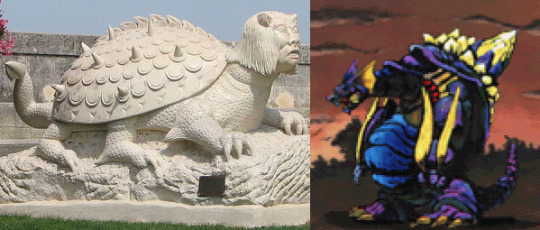
“Trask” is yet another transliteration* issue that comes from the juggling between languages. It actually comes from the Tarrasque, another monster most readily identified from its appearance in the original Dungeons & Dragons Monster Manual, itself originally taken from semi-obscure French myth of Saint Martha of Bethany and the Tarasque of Tarascon.
*(I realize I use this word a lot and it might not be as common use to others. A “translation” lifts meaning between languages; a “transliteration” is to lift written characters between them. Example: “Left” in English translates to 左[the direction] or 残[what remains] but transliterates to レフト. Inversely 左 and 残 both translate back to English as “Left” but transliterate as “hidari” and “zan” respectively; and レフト transliterates back into English as “refuto.”)

Surprisingly, the Wild Arms 2 design (which would also go on to persist as the core design throughout the rest of the Wild Arms series) is based more on the original myth than the D&D representations tend to be: While the end product looks nothing like the depictions of the Tarasque of myth, it retains the spiked turtle shell, the prominent dual horns, poisonous quality, and fins on its head here account for being “half fish.”
Also of note is that the title card identifies it as a “Dragonoid” and it has various metallic and machine-like features. These details are neat because it positions it as being not-quite a dragon, to work around a fact that will pop up much later: That dragons in Filgaia are extinct. And also to play into the fact that Dragons in Wild Arms are semi-mechanical lifeforms.
In any case, our scripted loss to Trask the first time around ends with the team knocked out and imprisoned in what appears to be a disused execution ground and associated holding cells. In our escape we run into monsters fitting the theme, who appear to be natural inhabitants, rather than guards put in place by the Odessa terrorist soldiers who are actually holding us here.
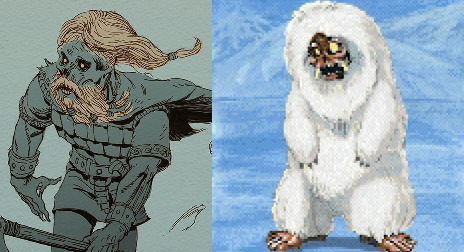
First up is the Wight, a classic undead warrior monster generally taken from D&D, but with a little more behind it than you might expect. The term Wight in English lore actually traces back quite far as an archaic term with little to no real association with monsters. The real intersection with name and subject comes from an early English translation of the Nordic Grettis Saga; In it the zombie-like creatures now better known as Draugr were referred to as apturgangr (lit.”againwalker”) but were translated as Barrow-wight. (lit.”[burial-]mound person”)
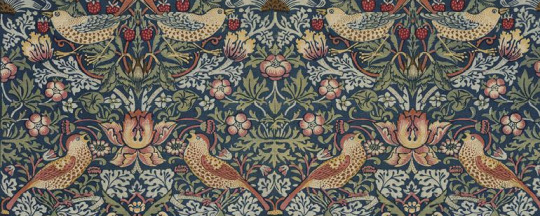
This may seem an odd choice, but the translation came at the hands of the eminent bookman William Morris. I say “bookman” because he was not just a prolific author of prose and poetry, but a pioneer of the revival of the British textile and printing industry. He and his wife, Jane Burden, did extensive arts, craft and design work in book and print design, book binding, and wall paper all stemming from the intricate design of modular and tiled printing blocks and stamps. Oh and he translated various works of epic poetry and myth into English, including old Roman epics, French knightly romances, and of course Norse sagas. (all of which he wrote and published what was basically fanfiction of, btw)
His seemingly erroneous “translation” of the Barrow-wight came as an attempt to reflect a comparable agedness to the name: Rather than translating from old Norse into modern English, he chose what he thought a suitable old English equivalent; “Barrow” referring to pre-christian Anglo-Saxon burial mounds, and “Wight” meaning “thing” or “creature” but often used disparagingly to refer to a person. The nuance there is actually quite clever, as the old Wight referred pretty exclusively to those living, even if it didn’t specify by definition, and that uncertainty or contradictory kind of implication uniquely fits a description of the undead.
This term would be picked up by J.R.R. Tolkein for use in Middle-Earth, retaining their lore and function from Norse legend to describe undead warriors. And from there you can follow the usual chain of influence to D&D, where the shortened term Wight really solidified itself as synonymous with the undead, and eventually down to Game of Thrones, where George R.R. Martin cleverly brings the whole thing back around to old risen bodies of northern warriors, not unlike the Draugr of Norse myth.
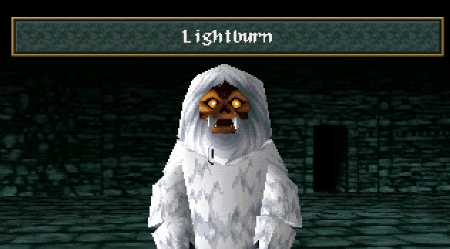
Anyway in Wild Arms 2 we get some sorta death yeti ¯\_(ツ)_/¯
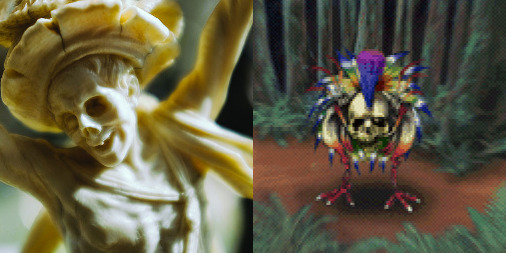
Next up is the Ghoul, which I think we all know is a pretty generic term in modern parlance, but it’s specific origins date back to pre-Islamic Arabia. It entered into English via translations of the original French translation of 1001 Arabian Nights, where it appears in one story as a monster lurking about the cemetery devouring corpses.
The Ghoul identity as a corpse eater quickly broadened into flesh eaters, and the association with lurking about graves in turn marked them as undead themselves until eventually the term became loosely applied to any variety of undead, including the thrall of vampires, supplanting the flesh of the dead with blood of the living and achieving a truly far removed meaning. Even in modern Arabic the term now broadly applies to any number of fantasy monsters.

And so long as we’re dabbling in pop culture transplants; the Arabaian word Ghul is in fact the same used in the name of the Batman villain, R’as al-Ghul, whose name/title has always been erroneously translated as “Head of The Demon.“

I have no idea why it’s a chicken with a mohawk but i love it
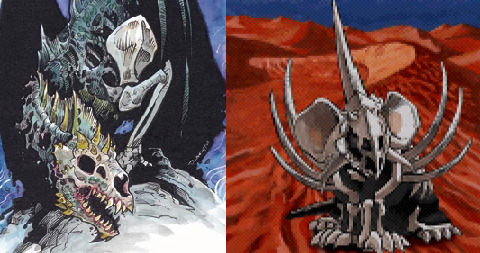
And finally the Bone Drake. I don’t know that this one actually has any real specific lineage...
“Drake” is generally a synonym for dragon, although there is some case of fantasy semantics where different settings will try to define distinct body types of dragons each with their own name, in which case Drakes are often either dragons which simply don’t exceed a certain size (generally no bigger than a non-magical animal such as a dog or a horse) or a wingless variation of whatever the setting’s prototypical dragon might be. I don’t know for certain, but I think this distinction in modern fantasy started with Tolkien’s wingless fire breathing dragon, Glaurung, and its offspring who were referred to as fire-drakes.
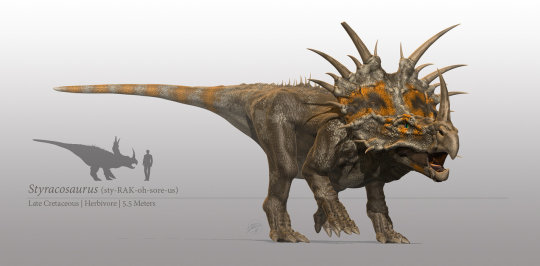
In any case, the specific term “Bone Drake” Doesn’t seem to appear with any visibility prior to Wild Arms 2, which leads me to believe it was just their name for a generic bone dragon-like creature. It does make for an interesting companion, aesthetically, to Trask being here, although there don’t seem to be any implications that Trask lives in this dungeon at all. Other than just being an obvious combination of cool fantasy things, it may also be pulled from Dungeon & Dragons’ Dracolich/Night Dragon; an undead (often skeletal) dragon raised from the dead, often by their own necromantic spells, hence the term “Lich.” For whatever reason they are oddly reminiscent of shield crested dinosaurs like the Triceratops or Styracosaurus.
The attack Rhodon Breath doesn’t tell me anything either. I think it’s just meant as “Rose Breath,” translating the “Rhodon” bit pretty literally, and references the smell of roses being present as a funeral, or else the palor of the faded pink color also called “Rose Breath.” There is some apocryphal reference to a Rhodon but of no significance that I can tell.
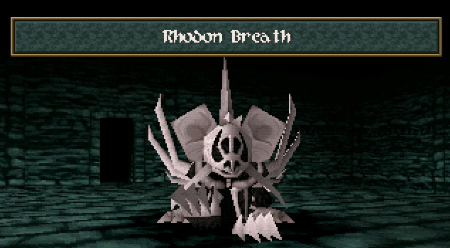
Clearly the theme here is death and the undead, and with some small stretch on part of the Wight, we could even say skulls all befitting Golgotha’s “Place of Skulls” epithet. It’s a really neat way to build this dungeon, albeit a little on the nose. But I really like the idea that the dungeon appears to be abandoned and now haunted by all these reanimated corpses and bones before the villains arrive to use it for their plans. Oddly there isn’t much of a martyrdom theme here, although we’ll get plenty of that a little later once we recruit our second magic user, summoner, christ figure, and perfect beautiful boy, Tim Rhymless to the team...
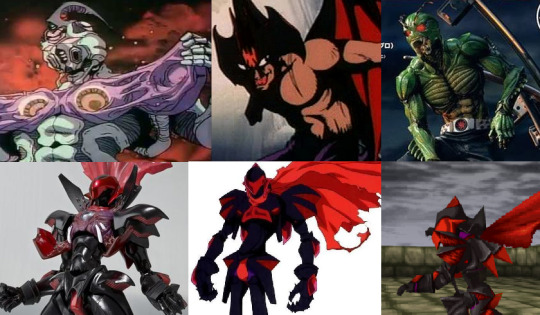
Anyway we get out, we fight Trask for real. Ashley turns into a saturday morning superhero. Trask gets solo’d. And we all just kinda move along without asking too many questions... Although the game dialogue describes this new form as a “grotesque black knight” the sprite work, 3D model, and even original character art don’t really convey much in the way of “grotesque” but in the context of the tokusatsu, henshin hero elements it’s not too hard to imagine that the design was meant to evoke a similar aesthetic to gruesome suit heroes like Guyver, Kamen Rider Shin, and Devilman. I do love the gill/tendon-like organic vent structure in the pauldrons that stay. And although it’s not visible in any of these images, but the D-Arts model has an exposed segment of vertebrae between the shoulders; that along with the teeth(?)/ribs on the open chest panels really helps bring out more of the “grotesque” quality of the design.
16 notes
·
View notes
Text
Dracula (2020) - S01 E01 - The Rules of the Beast

It’s not October already, is it?!
The Beeb’s mini-series game has been really on point in the past few months or so, huh? Whilst I was seeing Zombieland 2 I had a trailer for ‘His Dark Materials’ which looked pretty epic and then I found out about their new version of A Christmas Carol whilst researching the musical one I just watched, spoiler for Christmas marathon 2020 on that BTW. Now, we have the latest in a long line of Dracula adaptations. Apparently there’s another on the way in the form of a Renfield movie directed by Dexter Fletcher.
I say Beeb but they’re making these in conjunction with others, HDM with HBO, Christmas Carol with FX and this with Netflix. Presumably this will lead to Dracula being available worldwide, I know the BBC output doesn’t usually travel outside of the confines of UK Netflix (unless you’re using VPNs) so it’s good that everyone will get to experience this.
This represents not only some unseasonal content for me, it’s also uncharacteristically fresh given that it only aired just a few days ago, with one episode airing each night across the 1st, 2nd and 3rd of January. I must say it’s really strange to be viewing content that you can list as 2020, we’re more used to things marked like 1940 in this house. I could have put it off until October I suppose but why not get in whilst it’s topical? Plus it’s made by Steven Moffat and Mark Gatiss, they of Sherlock fame, so maybe that’s good for some Tumblr clicks. I know you guys love you some Sherlock. There’s also a documentary that aired alongside the series called ‘In Search of Dracula’ in which Gatiss looks at the history of the character so that should make for some interesting viewing too, much like his other looks at horror movies throughout the years that I’ve looked at previously.
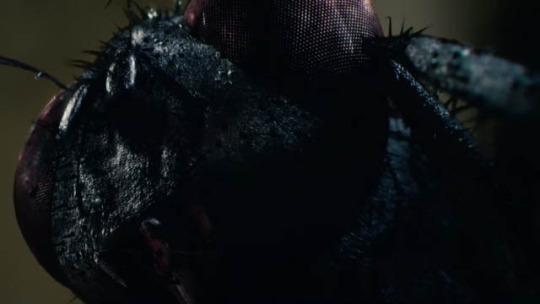
Pretty much the first thing you see at the start is a fly, like right up close and personal as it effectively lands on the camera lens. These things are everywhere throughout the episode, not just around food or the rotting bodies that come up later, that would make sense. During the scenes at Dracula’s castle you see them landing on paintings or swarming around what is to be Jonathan Harker’s bed and I’m not sure what the symbolism is meant to be. It’s at that point that Dracula makes explicit reference to them, suggesting they are man’s companion to the end and that where there is flesh, there are flies. Flies are obviously attracted to rotting material so possibly this speaks to how we find Dracula initially, very old and haggard, or just to the history of bloodshed and murder that has existed in the castle over what must be hundreds of years at this point.

There is one moment very early on in which a fly lands on Harker’s eye and actually crawls inside his head, a silhouette of the insect can be seen passing over the back of his eye. Just a really creepy and unsettling visual to see only 3 minutes in.
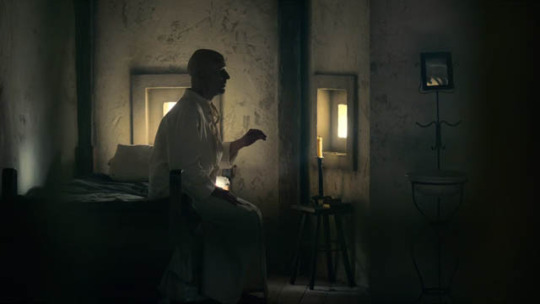
It’s strange that something as simple as a fly triggered a thought in me that we must be about to meet either the Renfield or Harker character, albeit in a state I wasn’t expecting at this point. I guess the two Renfield performances in the original Universal Dracula and it’s Spanish equivalent just really stuck with me and made me instantly connect the two. Harker finds himself in a convent being interviewed by a pair of nuns about his experiences in Dracula’s castle and how he came to make his escape. He’s actually asked if he and Dracula had sex during this time which is an interesting question.

Putting aside all the potentially shipping and fanfiction that it might inspire, in a rational world that wouldn’t acknowledge the possibility of Dracula or vampires being real, some sort of STI might be a reasonable assumption to make on Harker’s rather sudden and drastic collapse in health. He’s got these scabs all over his face, darkened sunken in eyes, any sembelence of colour completely washed away...guy is pretty much looking like a ghoul or zombie at this point. The other vampires we see later on are more akin to what you expect zombies to be like in other movies, they are the undead after all but I guess vampires are normally portrayed differently, keeping more of their humanity and coming across almost sexy in a brooding, gothic way.
It can be a little jarring at times to go back and forth between the convent and the castle but I suppose that’s a little more in line with how the original novel played out in journal entries and the like. This mini-series approach has given the creators the chance to dedicate much of this feature length runtime to Harker’s story within the castle walls, his first meeting with Dracula and his gradual descent into the husk he’s become now. Going back to the Universal version, it seemed a very brief transition, Renfield arrives and pretty much overnight becomes the gibbering slave to his new master. Here though, Harker never quite reaches that level of insanity but you can see how he might; isolated throughout the day whilst Dracula sleeps and with no one else around, he has this compulsion to search the castle in search of answers for the weird things he’s been seeing.
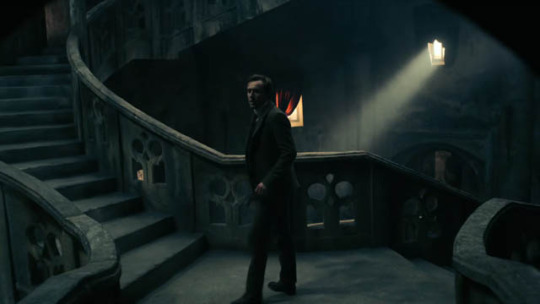
This is a really cool sequence with Harker’s narration describing the twisting and turning nature of the castle’s construction, with every door he opens somehow leading to another two or three. The images will seemingly repeat with him entering one hallway, making his way through and then coming through the entrance again. It reinforces the maze like quality and the repetition he is going through but also creates a sense of mystery. Sometimes there will be a brief glimpse of a shadowy figure moving through a doorway in the background, is this just another past version of Harker to underline the previous point or are there other people or creatures in this labyrinth?

And whether it’s through exhaustion, the eventual attacks he suffers or just some possible mind altering trick of Dracula’s, there are times when Harker drifts in and out of consciousness. In one moment, he finds himself awakened over his work at a table as Dracula hovers over him, offering him a glass of wine. In a bleary eyed state, Harker comes to find Dracula suddenly looks almost rejuvenated, looking far younger than he had previously. It all gives proceedings a very nightmarish quality.
Dracula benefits also from being immensely more threatening here than I recall him being in the Universal version. Well, aside from the voice of his initial form that is. People will often imitate the Lugosi voice but here he sounds like the bloody Meerkat from the adverts. Most of the most menacing moments come towards the end of this particular episode when his violent nature is truly unleashed but he seems very knowing and calculated early on, almost toying with Harker. It can come across a little cheesy at times because there is some very deliberate language choices that Harker himself is oblivious to but Dracula and we the audience know the true meaning behind. Like, Dracula suggesting that the locals lack ‘flavour’ to which Harker suggests he might mean ‘character’.

There is one frantic scene where Harker stumbles upon Dracula’s coffin and inadvertently awakens him, leading to Dracula setting upon him with bared fangs before the scene abruptly cuts away from the screams of Harker. It’s a very Christopher Lee-esque image, of this one in particular.
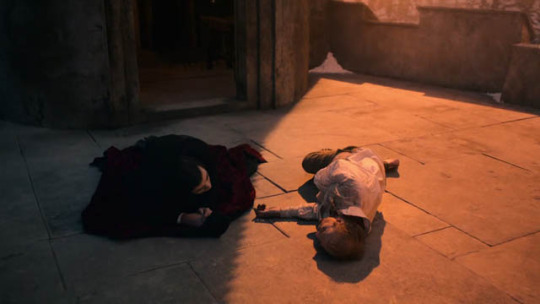
As the tides turn, Dracula’s strength and vigor increasing as Harker’s is drained, Dracula becomes a bit more blunt in revealing his motivations but still Harker remains defiant to the end which lends him more sympathy. There’s an almost tender moment when Dracula takes Harker to the ramparts of his castle, laying his enfeebled body in the light so that the morning sun might vanquish him whilst he watches from the shadows, speaking softly of how beautiful the sun is and how Harker should embrace death. As Harker begs to be spared, he does so with the promise that he will do everything within his power to stop Dracula.
With the later revelation about Mina, I did wonder if there would be some ongoing story arc about the struggle for Harker, his want to retain his humanity versus the growing urge to fulfil the desires of the vampire’s curse and his master. But, going by the ending, the struggle is already over. And boy, what an ending.

“They’re not my eyes...”
That’s a really great shot BTW, the rest of her face and pretty much the rest of the frame being in shadow except for her eyes, really lets you focus in on them and her expression as the reality of the situation sinks in.
It really is an exclamation point on what was a very brutal and bloody affair at times. The Christopher Lee reference earlier is quite apt as this is the kind of thing I would expect from those Hammer movies. I’ve always been hesitant to watch those as there’s so many, like 7 Frankenstein and 8 Dracula movies, so to experience something in that style but in a more condensed and standalone format is ideal.
Stay tuned for the next two entries!
1 note
·
View note